Finance for Strategic Managers: Financial Information Report
VerifiedAdded on 2020/01/15
|20
|7341
|167
Report
AI Summary
This report, focused on finance for strategic managers, delves into the critical aspects of financial management within a business context. It begins by assessing the financial information needs of various stakeholders, including managers, employees, shareholders, and suppliers, highlighting how financial statements inform their decision-making processes. The report then identifies and analyzes the business risks associated with financial decisions, such as strategic and operational risks, and their potential financial impacts. It emphasizes the importance of income statements, balance sheets, and cash flow statements in providing managers with the necessary data for strategic business decisions. Furthermore, the report explains the purpose, structure, and content of published accounts, including their role in building stakeholder trust, and demonstrates the interpretation of financial information through ratio analysis to support strategic decision-making. It also differentiates between long and short-term financial requirements and explores various financing sources. Finally, the report contrasts the roles and responsibilities of owners and managers in making business decisions and evaluates methods for appraising investment projects, providing a comprehensive overview of financial management principles.
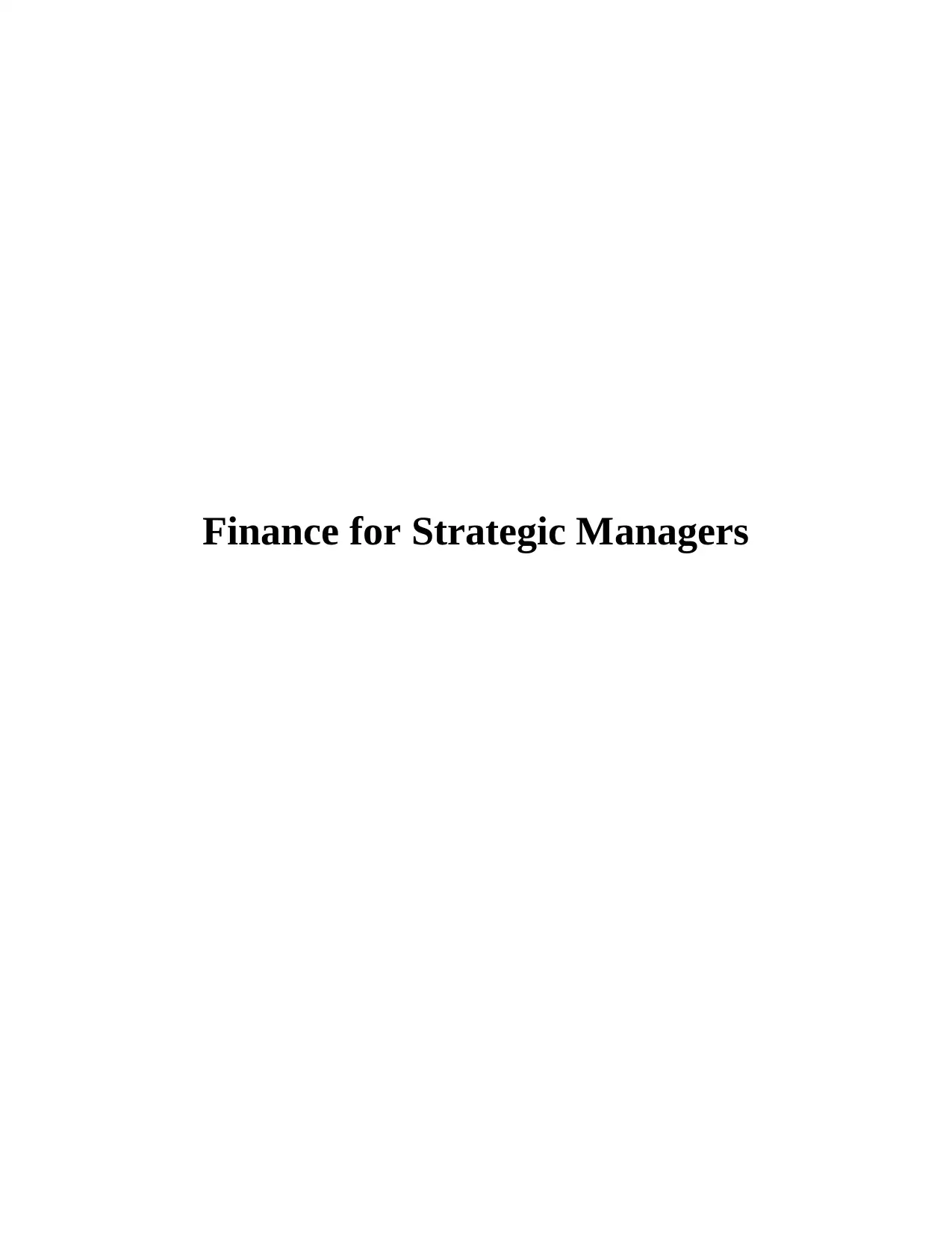
Finance for Strategic Managers
Paraphrase This Document
Need a fresh take? Get an instant paraphrase of this document with our AI Paraphraser
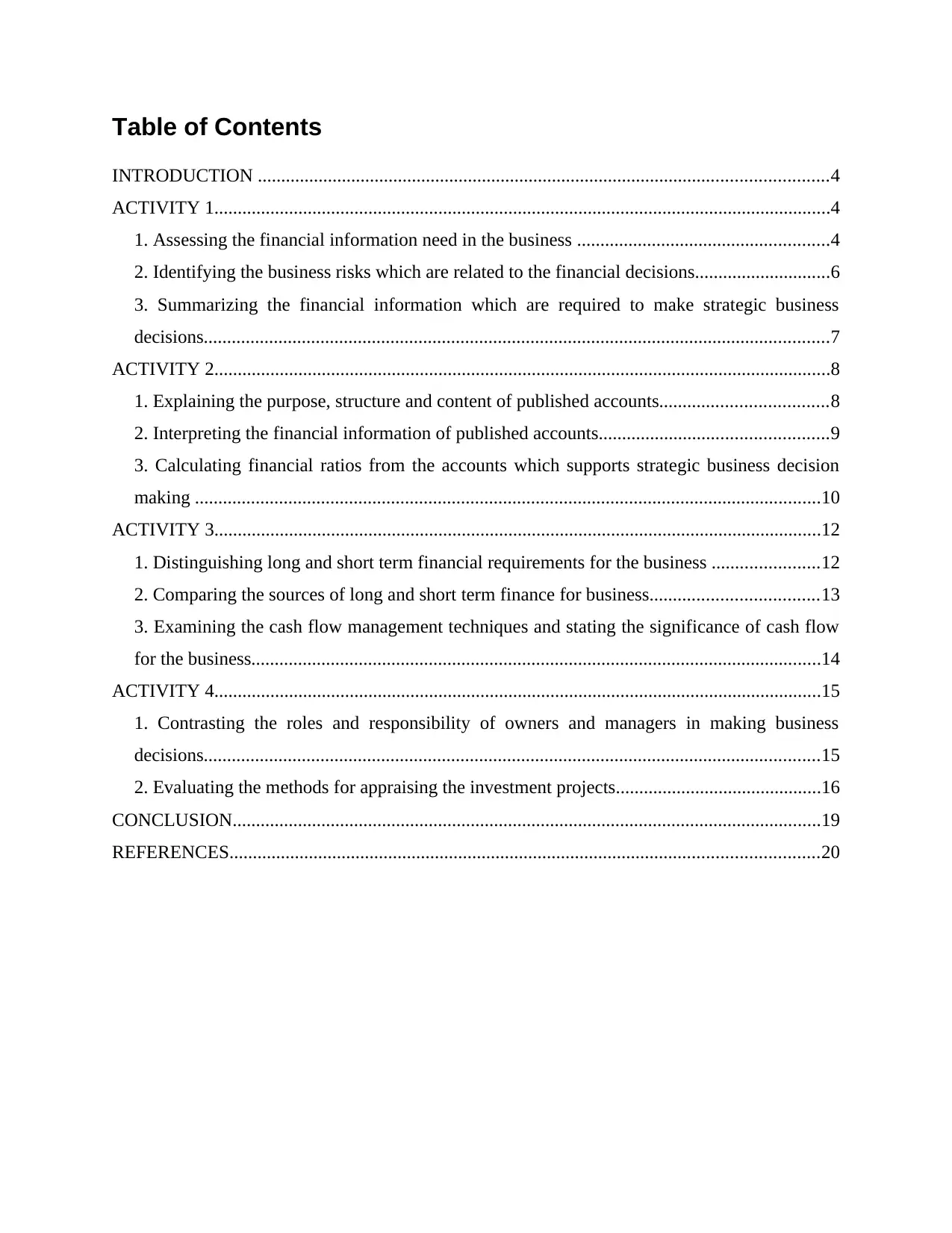
Table of Contents
INTRODUCTION ..........................................................................................................................4
ACTIVITY 1....................................................................................................................................4
1. Assessing the financial information need in the business ......................................................4
2. Identifying the business risks which are related to the financial decisions.............................6
3. Summarizing the financial information which are required to make strategic business
decisions......................................................................................................................................7
ACTIVITY 2....................................................................................................................................8
1. Explaining the purpose, structure and content of published accounts....................................8
2. Interpreting the financial information of published accounts.................................................9
3. Calculating financial ratios from the accounts which supports strategic business decision
making ......................................................................................................................................10
ACTIVITY 3..................................................................................................................................12
1. Distinguishing long and short term financial requirements for the business .......................12
2. Comparing the sources of long and short term finance for business....................................13
3. Examining the cash flow management techniques and stating the significance of cash flow
for the business..........................................................................................................................14
ACTIVITY 4..................................................................................................................................15
1. Contrasting the roles and responsibility of owners and managers in making business
decisions....................................................................................................................................15
2. Evaluating the methods for appraising the investment projects............................................16
CONCLUSION..............................................................................................................................19
REFERENCES..............................................................................................................................20
INTRODUCTION ..........................................................................................................................4
ACTIVITY 1....................................................................................................................................4
1. Assessing the financial information need in the business ......................................................4
2. Identifying the business risks which are related to the financial decisions.............................6
3. Summarizing the financial information which are required to make strategic business
decisions......................................................................................................................................7
ACTIVITY 2....................................................................................................................................8
1. Explaining the purpose, structure and content of published accounts....................................8
2. Interpreting the financial information of published accounts.................................................9
3. Calculating financial ratios from the accounts which supports strategic business decision
making ......................................................................................................................................10
ACTIVITY 3..................................................................................................................................12
1. Distinguishing long and short term financial requirements for the business .......................12
2. Comparing the sources of long and short term finance for business....................................13
3. Examining the cash flow management techniques and stating the significance of cash flow
for the business..........................................................................................................................14
ACTIVITY 4..................................................................................................................................15
1. Contrasting the roles and responsibility of owners and managers in making business
decisions....................................................................................................................................15
2. Evaluating the methods for appraising the investment projects............................................16
CONCLUSION..............................................................................................................................19
REFERENCES..............................................................................................................................20
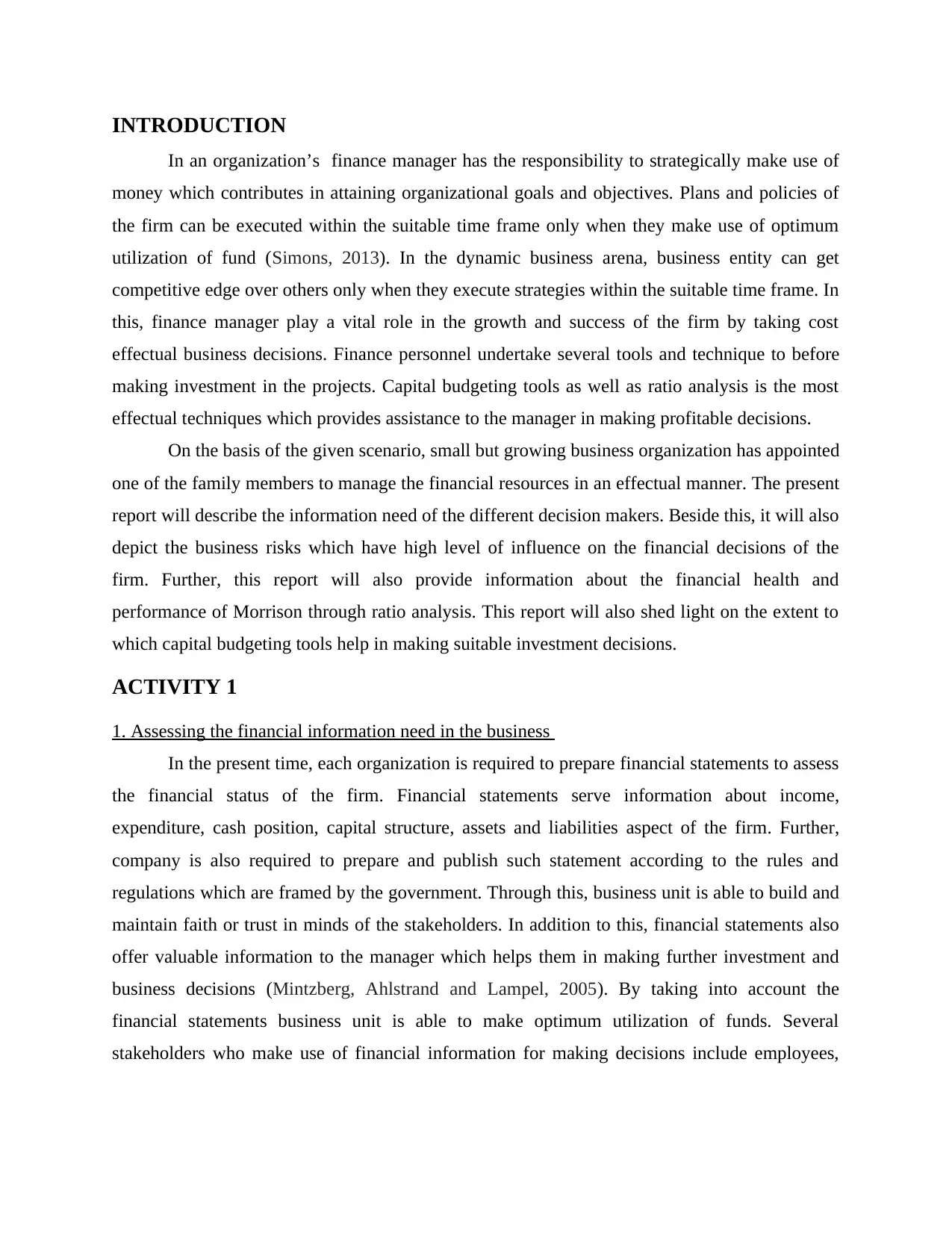
INTRODUCTION
In an organization’s finance manager has the responsibility to strategically make use of
money which contributes in attaining organizational goals and objectives. Plans and policies of
the firm can be executed within the suitable time frame only when they make use of optimum
utilization of fund (Simons, 2013). In the dynamic business arena, business entity can get
competitive edge over others only when they execute strategies within the suitable time frame. In
this, finance manager play a vital role in the growth and success of the firm by taking cost
effectual business decisions. Finance personnel undertake several tools and technique to before
making investment in the projects. Capital budgeting tools as well as ratio analysis is the most
effectual techniques which provides assistance to the manager in making profitable decisions.
On the basis of the given scenario, small but growing business organization has appointed
one of the family members to manage the financial resources in an effectual manner. The present
report will describe the information need of the different decision makers. Beside this, it will also
depict the business risks which have high level of influence on the financial decisions of the
firm. Further, this report will also provide information about the financial health and
performance of Morrison through ratio analysis. This report will also shed light on the extent to
which capital budgeting tools help in making suitable investment decisions.
ACTIVITY 1
1. Assessing the financial information need in the business
In the present time, each organization is required to prepare financial statements to assess
the financial status of the firm. Financial statements serve information about income,
expenditure, cash position, capital structure, assets and liabilities aspect of the firm. Further,
company is also required to prepare and publish such statement according to the rules and
regulations which are framed by the government. Through this, business unit is able to build and
maintain faith or trust in minds of the stakeholders. In addition to this, financial statements also
offer valuable information to the manager which helps them in making further investment and
business decisions (Mintzberg, Ahlstrand and Lampel, 2005). By taking into account the
financial statements business unit is able to make optimum utilization of funds. Several
stakeholders who make use of financial information for making decisions include employees,
In an organization’s finance manager has the responsibility to strategically make use of
money which contributes in attaining organizational goals and objectives. Plans and policies of
the firm can be executed within the suitable time frame only when they make use of optimum
utilization of fund (Simons, 2013). In the dynamic business arena, business entity can get
competitive edge over others only when they execute strategies within the suitable time frame. In
this, finance manager play a vital role in the growth and success of the firm by taking cost
effectual business decisions. Finance personnel undertake several tools and technique to before
making investment in the projects. Capital budgeting tools as well as ratio analysis is the most
effectual techniques which provides assistance to the manager in making profitable decisions.
On the basis of the given scenario, small but growing business organization has appointed
one of the family members to manage the financial resources in an effectual manner. The present
report will describe the information need of the different decision makers. Beside this, it will also
depict the business risks which have high level of influence on the financial decisions of the
firm. Further, this report will also provide information about the financial health and
performance of Morrison through ratio analysis. This report will also shed light on the extent to
which capital budgeting tools help in making suitable investment decisions.
ACTIVITY 1
1. Assessing the financial information need in the business
In the present time, each organization is required to prepare financial statements to assess
the financial status of the firm. Financial statements serve information about income,
expenditure, cash position, capital structure, assets and liabilities aspect of the firm. Further,
company is also required to prepare and publish such statement according to the rules and
regulations which are framed by the government. Through this, business unit is able to build and
maintain faith or trust in minds of the stakeholders. In addition to this, financial statements also
offer valuable information to the manager which helps them in making further investment and
business decisions (Mintzberg, Ahlstrand and Lampel, 2005). By taking into account the
financial statements business unit is able to make optimum utilization of funds. Several
stakeholders who make use of financial information for making decisions include employees,
⊘ This is a preview!⊘
Do you want full access?
Subscribe today to unlock all pages.

Trusted by 1+ million students worldwide
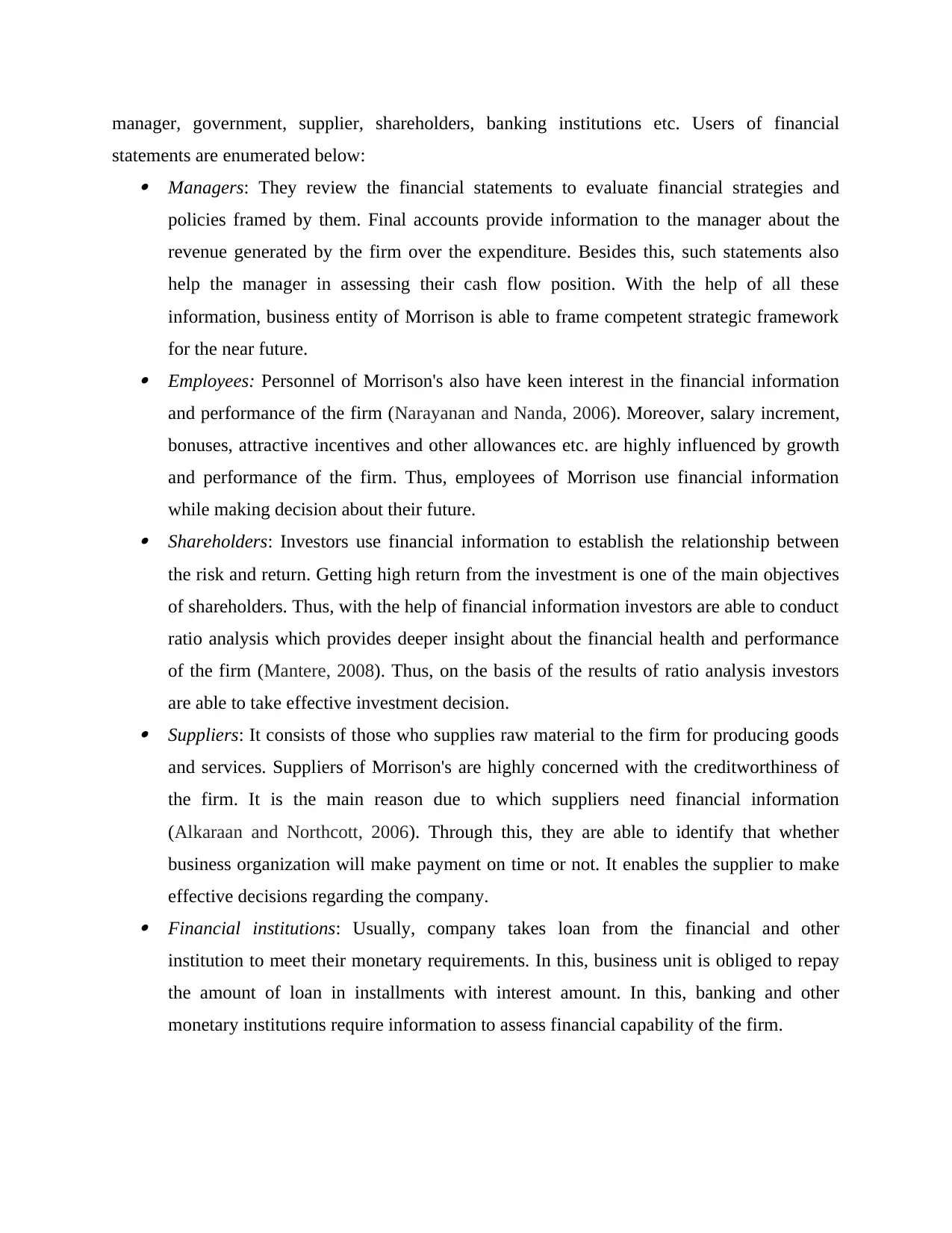
manager, government, supplier, shareholders, banking institutions etc. Users of financial
statements are enumerated below: Managers: They review the financial statements to evaluate financial strategies and
policies framed by them. Final accounts provide information to the manager about the
revenue generated by the firm over the expenditure. Besides this, such statements also
help the manager in assessing their cash flow position. With the help of all these
information, business entity of Morrison is able to frame competent strategic framework
for the near future. Employees: Personnel of Morrison's also have keen interest in the financial information
and performance of the firm (Narayanan and Nanda, 2006). Moreover, salary increment,
bonuses, attractive incentives and other allowances etc. are highly influenced by growth
and performance of the firm. Thus, employees of Morrison use financial information
while making decision about their future. Shareholders: Investors use financial information to establish the relationship between
the risk and return. Getting high return from the investment is one of the main objectives
of shareholders. Thus, with the help of financial information investors are able to conduct
ratio analysis which provides deeper insight about the financial health and performance
of the firm (Mantere, 2008). Thus, on the basis of the results of ratio analysis investors
are able to take effective investment decision. Suppliers: It consists of those who supplies raw material to the firm for producing goods
and services. Suppliers of Morrison's are highly concerned with the creditworthiness of
the firm. It is the main reason due to which suppliers need financial information
(Alkaraan and Northcott, 2006). Through this, they are able to identify that whether
business organization will make payment on time or not. It enables the supplier to make
effective decisions regarding the company. Financial institutions: Usually, company takes loan from the financial and other
institution to meet their monetary requirements. In this, business unit is obliged to repay
the amount of loan in installments with interest amount. In this, banking and other
monetary institutions require information to assess financial capability of the firm.
statements are enumerated below: Managers: They review the financial statements to evaluate financial strategies and
policies framed by them. Final accounts provide information to the manager about the
revenue generated by the firm over the expenditure. Besides this, such statements also
help the manager in assessing their cash flow position. With the help of all these
information, business entity of Morrison is able to frame competent strategic framework
for the near future. Employees: Personnel of Morrison's also have keen interest in the financial information
and performance of the firm (Narayanan and Nanda, 2006). Moreover, salary increment,
bonuses, attractive incentives and other allowances etc. are highly influenced by growth
and performance of the firm. Thus, employees of Morrison use financial information
while making decision about their future. Shareholders: Investors use financial information to establish the relationship between
the risk and return. Getting high return from the investment is one of the main objectives
of shareholders. Thus, with the help of financial information investors are able to conduct
ratio analysis which provides deeper insight about the financial health and performance
of the firm (Mantere, 2008). Thus, on the basis of the results of ratio analysis investors
are able to take effective investment decision. Suppliers: It consists of those who supplies raw material to the firm for producing goods
and services. Suppliers of Morrison's are highly concerned with the creditworthiness of
the firm. It is the main reason due to which suppliers need financial information
(Alkaraan and Northcott, 2006). Through this, they are able to identify that whether
business organization will make payment on time or not. It enables the supplier to make
effective decisions regarding the company. Financial institutions: Usually, company takes loan from the financial and other
institution to meet their monetary requirements. In this, business unit is obliged to repay
the amount of loan in installments with interest amount. In this, banking and other
monetary institutions require information to assess financial capability of the firm.
Paraphrase This Document
Need a fresh take? Get an instant paraphrase of this document with our AI Paraphraser
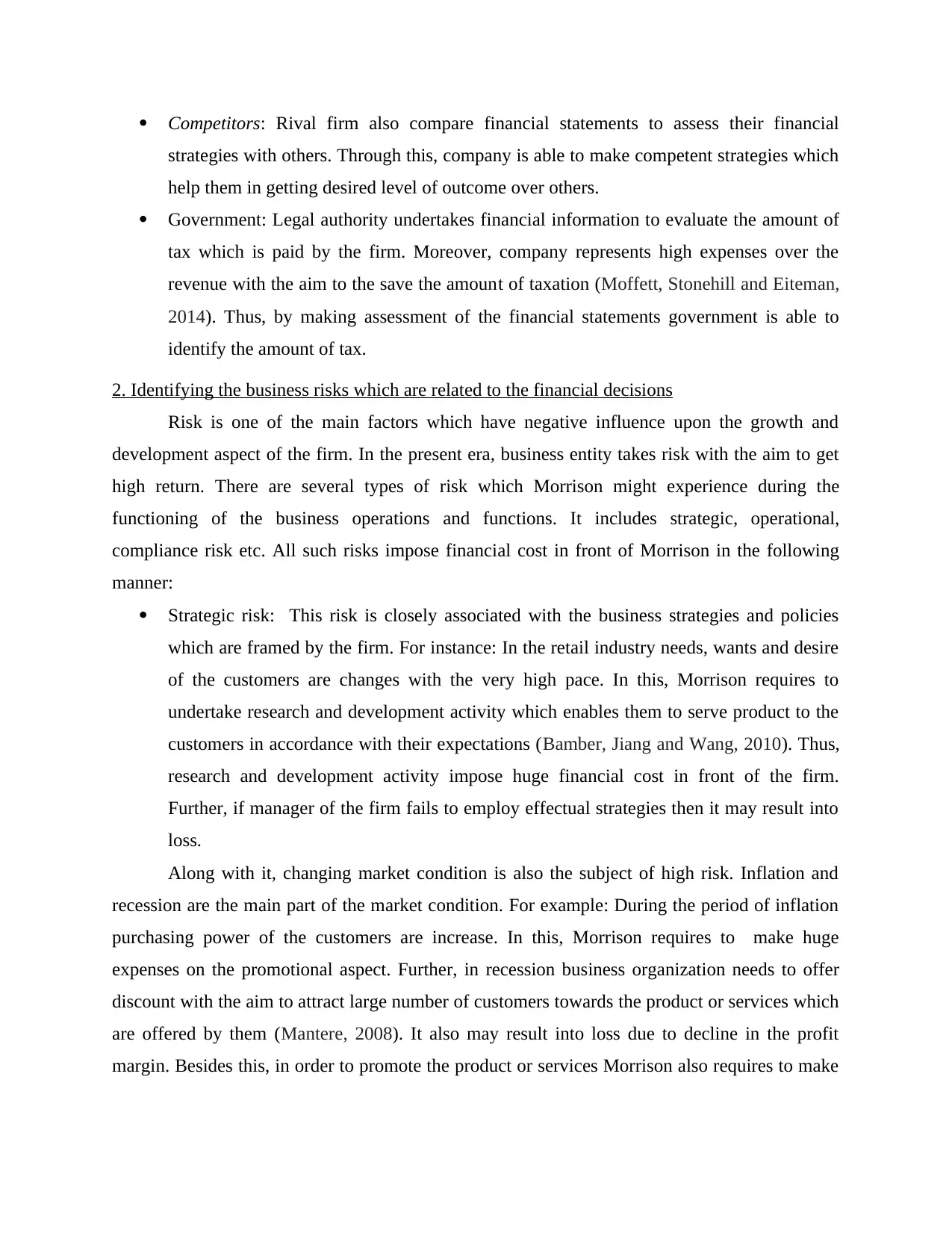
Competitors: Rival firm also compare financial statements to assess their financial
strategies with others. Through this, company is able to make competent strategies which
help them in getting desired level of outcome over others.
Government: Legal authority undertakes financial information to evaluate the amount of
tax which is paid by the firm. Moreover, company represents high expenses over the
revenue with the aim to the save the amount of taxation (Moffett, Stonehill and Eiteman,
2014). Thus, by making assessment of the financial statements government is able to
identify the amount of tax.
2. Identifying the business risks which are related to the financial decisions
Risk is one of the main factors which have negative influence upon the growth and
development aspect of the firm. In the present era, business entity takes risk with the aim to get
high return. There are several types of risk which Morrison might experience during the
functioning of the business operations and functions. It includes strategic, operational,
compliance risk etc. All such risks impose financial cost in front of Morrison in the following
manner:
Strategic risk: This risk is closely associated with the business strategies and policies
which are framed by the firm. For instance: In the retail industry needs, wants and desire
of the customers are changes with the very high pace. In this, Morrison requires to
undertake research and development activity which enables them to serve product to the
customers in accordance with their expectations (Bamber, Jiang and Wang, 2010). Thus,
research and development activity impose huge financial cost in front of the firm.
Further, if manager of the firm fails to employ effectual strategies then it may result into
loss.
Along with it, changing market condition is also the subject of high risk. Inflation and
recession are the main part of the market condition. For example: During the period of inflation
purchasing power of the customers are increase. In this, Morrison requires to make huge
expenses on the promotional aspect. Further, in recession business organization needs to offer
discount with the aim to attract large number of customers towards the product or services which
are offered by them (Mantere, 2008). It also may result into loss due to decline in the profit
margin. Besides this, in order to promote the product or services Morrison also requires to make
strategies with others. Through this, company is able to make competent strategies which
help them in getting desired level of outcome over others.
Government: Legal authority undertakes financial information to evaluate the amount of
tax which is paid by the firm. Moreover, company represents high expenses over the
revenue with the aim to the save the amount of taxation (Moffett, Stonehill and Eiteman,
2014). Thus, by making assessment of the financial statements government is able to
identify the amount of tax.
2. Identifying the business risks which are related to the financial decisions
Risk is one of the main factors which have negative influence upon the growth and
development aspect of the firm. In the present era, business entity takes risk with the aim to get
high return. There are several types of risk which Morrison might experience during the
functioning of the business operations and functions. It includes strategic, operational,
compliance risk etc. All such risks impose financial cost in front of Morrison in the following
manner:
Strategic risk: This risk is closely associated with the business strategies and policies
which are framed by the firm. For instance: In the retail industry needs, wants and desire
of the customers are changes with the very high pace. In this, Morrison requires to
undertake research and development activity which enables them to serve product to the
customers in accordance with their expectations (Bamber, Jiang and Wang, 2010). Thus,
research and development activity impose huge financial cost in front of the firm.
Further, if manager of the firm fails to employ effectual strategies then it may result into
loss.
Along with it, changing market condition is also the subject of high risk. Inflation and
recession are the main part of the market condition. For example: During the period of inflation
purchasing power of the customers are increase. In this, Morrison requires to make huge
expenses on the promotional aspect. Further, in recession business organization needs to offer
discount with the aim to attract large number of customers towards the product or services which
are offered by them (Mantere, 2008). It also may result into loss due to decline in the profit
margin. Besides this, in order to promote the product or services Morrison also requires to make
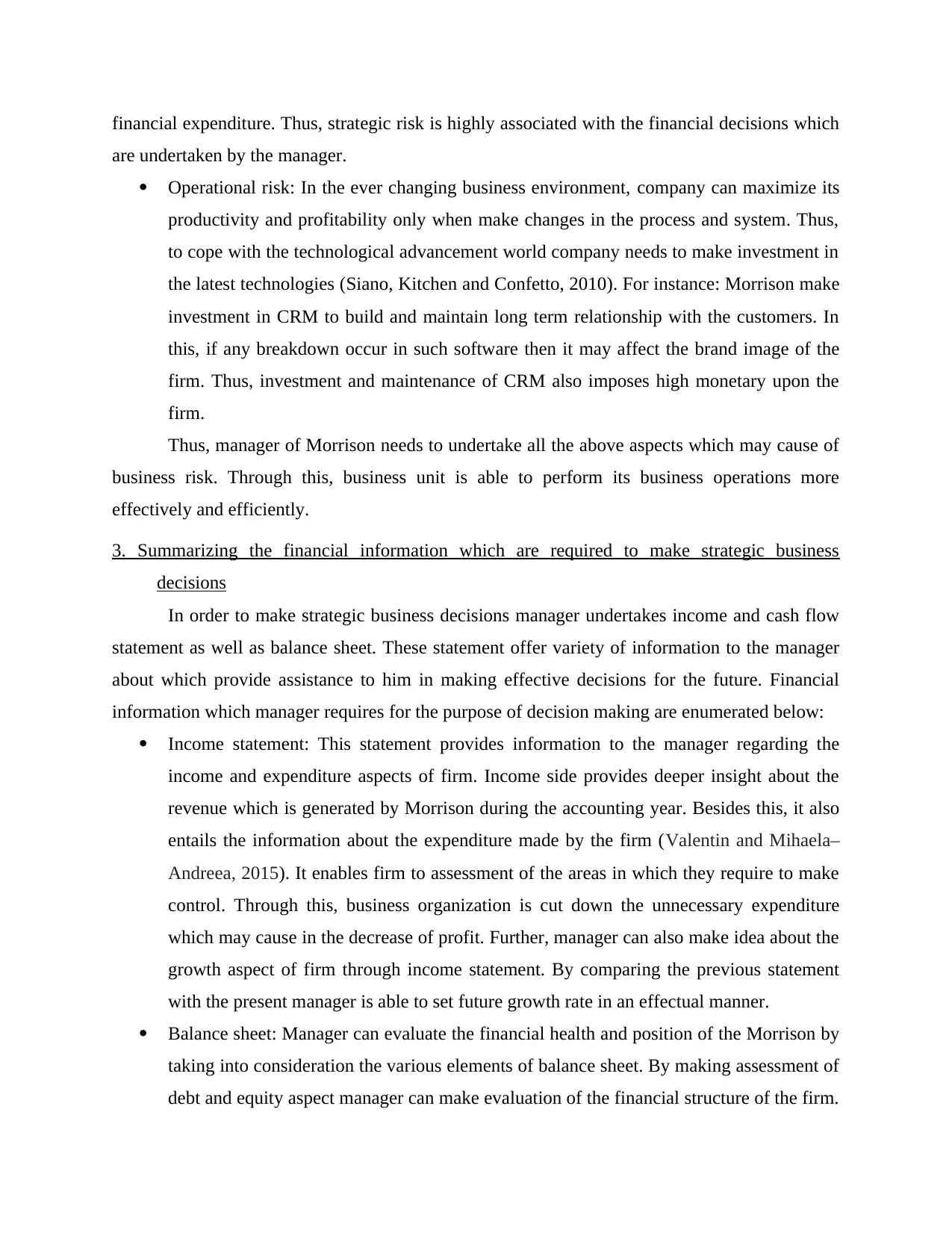
financial expenditure. Thus, strategic risk is highly associated with the financial decisions which
are undertaken by the manager.
Operational risk: In the ever changing business environment, company can maximize its
productivity and profitability only when make changes in the process and system. Thus,
to cope with the technological advancement world company needs to make investment in
the latest technologies (Siano, Kitchen and Confetto, 2010). For instance: Morrison make
investment in CRM to build and maintain long term relationship with the customers. In
this, if any breakdown occur in such software then it may affect the brand image of the
firm. Thus, investment and maintenance of CRM also imposes high monetary upon the
firm.
Thus, manager of Morrison needs to undertake all the above aspects which may cause of
business risk. Through this, business unit is able to perform its business operations more
effectively and efficiently.
3. Summarizing the financial information which are required to make strategic business
decisions
In order to make strategic business decisions manager undertakes income and cash flow
statement as well as balance sheet. These statement offer variety of information to the manager
about which provide assistance to him in making effective decisions for the future. Financial
information which manager requires for the purpose of decision making are enumerated below:
Income statement: This statement provides information to the manager regarding the
income and expenditure aspects of firm. Income side provides deeper insight about the
revenue which is generated by Morrison during the accounting year. Besides this, it also
entails the information about the expenditure made by the firm (Valentin and Mihaela–
Andreea, 2015). It enables firm to assessment of the areas in which they require to make
control. Through this, business organization is cut down the unnecessary expenditure
which may cause in the decrease of profit. Further, manager can also make idea about the
growth aspect of firm through income statement. By comparing the previous statement
with the present manager is able to set future growth rate in an effectual manner.
Balance sheet: Manager can evaluate the financial health and position of the Morrison by
taking into consideration the various elements of balance sheet. By making assessment of
debt and equity aspect manager can make evaluation of the financial structure of the firm.
are undertaken by the manager.
Operational risk: In the ever changing business environment, company can maximize its
productivity and profitability only when make changes in the process and system. Thus,
to cope with the technological advancement world company needs to make investment in
the latest technologies (Siano, Kitchen and Confetto, 2010). For instance: Morrison make
investment in CRM to build and maintain long term relationship with the customers. In
this, if any breakdown occur in such software then it may affect the brand image of the
firm. Thus, investment and maintenance of CRM also imposes high monetary upon the
firm.
Thus, manager of Morrison needs to undertake all the above aspects which may cause of
business risk. Through this, business unit is able to perform its business operations more
effectively and efficiently.
3. Summarizing the financial information which are required to make strategic business
decisions
In order to make strategic business decisions manager undertakes income and cash flow
statement as well as balance sheet. These statement offer variety of information to the manager
about which provide assistance to him in making effective decisions for the future. Financial
information which manager requires for the purpose of decision making are enumerated below:
Income statement: This statement provides information to the manager regarding the
income and expenditure aspects of firm. Income side provides deeper insight about the
revenue which is generated by Morrison during the accounting year. Besides this, it also
entails the information about the expenditure made by the firm (Valentin and Mihaela–
Andreea, 2015). It enables firm to assessment of the areas in which they require to make
control. Through this, business organization is cut down the unnecessary expenditure
which may cause in the decrease of profit. Further, manager can also make idea about the
growth aspect of firm through income statement. By comparing the previous statement
with the present manager is able to set future growth rate in an effectual manner.
Balance sheet: Manager can evaluate the financial health and position of the Morrison by
taking into consideration the various elements of balance sheet. By making assessment of
debt and equity aspect manager can make evaluation of the financial structure of the firm.
⊘ This is a preview!⊘
Do you want full access?
Subscribe today to unlock all pages.

Trusted by 1+ million students worldwide
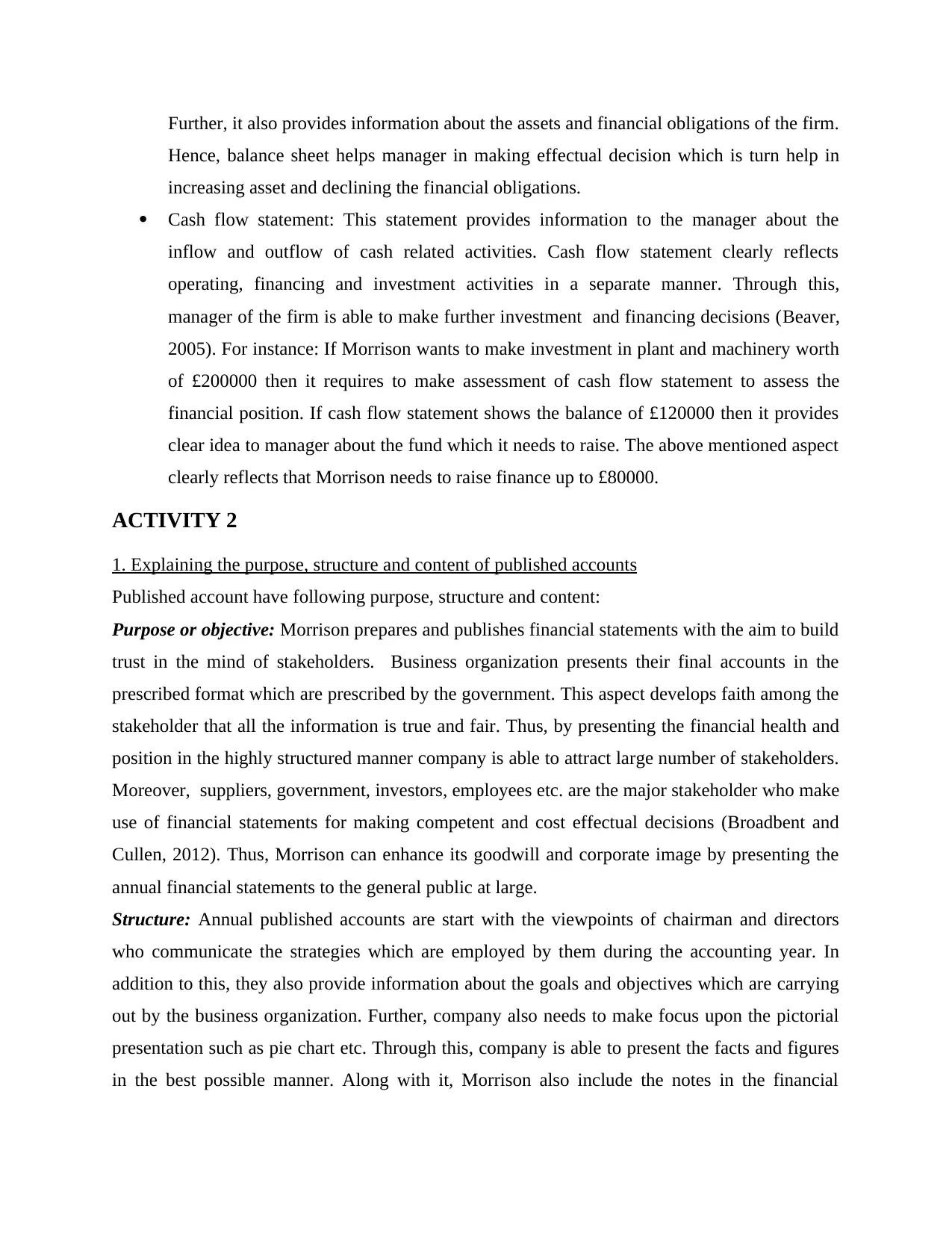
Further, it also provides information about the assets and financial obligations of the firm.
Hence, balance sheet helps manager in making effectual decision which is turn help in
increasing asset and declining the financial obligations.
Cash flow statement: This statement provides information to the manager about the
inflow and outflow of cash related activities. Cash flow statement clearly reflects
operating, financing and investment activities in a separate manner. Through this,
manager of the firm is able to make further investment and financing decisions (Beaver,
2005). For instance: If Morrison wants to make investment in plant and machinery worth
of £200000 then it requires to make assessment of cash flow statement to assess the
financial position. If cash flow statement shows the balance of £120000 then it provides
clear idea to manager about the fund which it needs to raise. The above mentioned aspect
clearly reflects that Morrison needs to raise finance up to £80000.
ACTIVITY 2
1. Explaining the purpose, structure and content of published accounts
Published account have following purpose, structure and content:
Purpose or objective: Morrison prepares and publishes financial statements with the aim to build
trust in the mind of stakeholders. Business organization presents their final accounts in the
prescribed format which are prescribed by the government. This aspect develops faith among the
stakeholder that all the information is true and fair. Thus, by presenting the financial health and
position in the highly structured manner company is able to attract large number of stakeholders.
Moreover, suppliers, government, investors, employees etc. are the major stakeholder who make
use of financial statements for making competent and cost effectual decisions (Broadbent and
Cullen, 2012). Thus, Morrison can enhance its goodwill and corporate image by presenting the
annual financial statements to the general public at large.
Structure: Annual published accounts are start with the viewpoints of chairman and directors
who communicate the strategies which are employed by them during the accounting year. In
addition to this, they also provide information about the goals and objectives which are carrying
out by the business organization. Further, company also needs to make focus upon the pictorial
presentation such as pie chart etc. Through this, company is able to present the facts and figures
in the best possible manner. Along with it, Morrison also include the notes in the financial
Hence, balance sheet helps manager in making effectual decision which is turn help in
increasing asset and declining the financial obligations.
Cash flow statement: This statement provides information to the manager about the
inflow and outflow of cash related activities. Cash flow statement clearly reflects
operating, financing and investment activities in a separate manner. Through this,
manager of the firm is able to make further investment and financing decisions (Beaver,
2005). For instance: If Morrison wants to make investment in plant and machinery worth
of £200000 then it requires to make assessment of cash flow statement to assess the
financial position. If cash flow statement shows the balance of £120000 then it provides
clear idea to manager about the fund which it needs to raise. The above mentioned aspect
clearly reflects that Morrison needs to raise finance up to £80000.
ACTIVITY 2
1. Explaining the purpose, structure and content of published accounts
Published account have following purpose, structure and content:
Purpose or objective: Morrison prepares and publishes financial statements with the aim to build
trust in the mind of stakeholders. Business organization presents their final accounts in the
prescribed format which are prescribed by the government. This aspect develops faith among the
stakeholder that all the information is true and fair. Thus, by presenting the financial health and
position in the highly structured manner company is able to attract large number of stakeholders.
Moreover, suppliers, government, investors, employees etc. are the major stakeholder who make
use of financial statements for making competent and cost effectual decisions (Broadbent and
Cullen, 2012). Thus, Morrison can enhance its goodwill and corporate image by presenting the
annual financial statements to the general public at large.
Structure: Annual published accounts are start with the viewpoints of chairman and directors
who communicate the strategies which are employed by them during the accounting year. In
addition to this, they also provide information about the goals and objectives which are carrying
out by the business organization. Further, company also needs to make focus upon the pictorial
presentation such as pie chart etc. Through this, company is able to present the facts and figures
in the best possible manner. Along with it, Morrison also include the notes in the financial
Paraphrase This Document
Need a fresh take? Get an instant paraphrase of this document with our AI Paraphraser
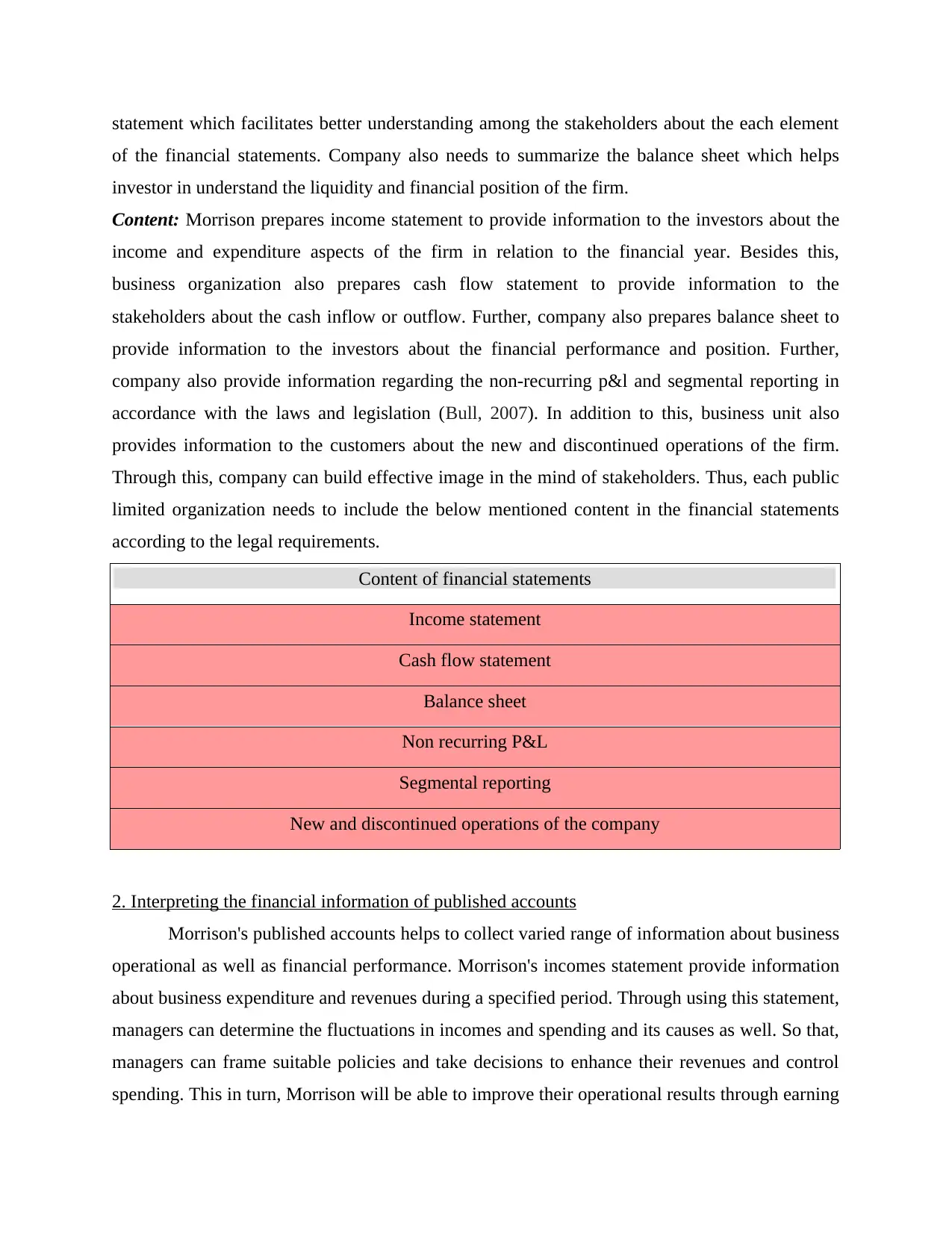
statement which facilitates better understanding among the stakeholders about the each element
of the financial statements. Company also needs to summarize the balance sheet which helps
investor in understand the liquidity and financial position of the firm.
Content: Morrison prepares income statement to provide information to the investors about the
income and expenditure aspects of the firm in relation to the financial year. Besides this,
business organization also prepares cash flow statement to provide information to the
stakeholders about the cash inflow or outflow. Further, company also prepares balance sheet to
provide information to the investors about the financial performance and position. Further,
company also provide information regarding the non-recurring p&l and segmental reporting in
accordance with the laws and legislation (Bull, 2007). In addition to this, business unit also
provides information to the customers about the new and discontinued operations of the firm.
Through this, company can build effective image in the mind of stakeholders. Thus, each public
limited organization needs to include the below mentioned content in the financial statements
according to the legal requirements.
Content of financial statements
Income statement
Cash flow statement
Balance sheet
Non recurring P&L
Segmental reporting
New and discontinued operations of the company
2. Interpreting the financial information of published accounts
Morrison's published accounts helps to collect varied range of information about business
operational as well as financial performance. Morrison's incomes statement provide information
about business expenditure and revenues during a specified period. Through using this statement,
managers can determine the fluctuations in incomes and spending and its causes as well. So that,
managers can frame suitable policies and take decisions to enhance their revenues and control
spending. This in turn, Morrison will be able to improve their operational results through earning
of the financial statements. Company also needs to summarize the balance sheet which helps
investor in understand the liquidity and financial position of the firm.
Content: Morrison prepares income statement to provide information to the investors about the
income and expenditure aspects of the firm in relation to the financial year. Besides this,
business organization also prepares cash flow statement to provide information to the
stakeholders about the cash inflow or outflow. Further, company also prepares balance sheet to
provide information to the investors about the financial performance and position. Further,
company also provide information regarding the non-recurring p&l and segmental reporting in
accordance with the laws and legislation (Bull, 2007). In addition to this, business unit also
provides information to the customers about the new and discontinued operations of the firm.
Through this, company can build effective image in the mind of stakeholders. Thus, each public
limited organization needs to include the below mentioned content in the financial statements
according to the legal requirements.
Content of financial statements
Income statement
Cash flow statement
Balance sheet
Non recurring P&L
Segmental reporting
New and discontinued operations of the company
2. Interpreting the financial information of published accounts
Morrison's published accounts helps to collect varied range of information about business
operational as well as financial performance. Morrison's incomes statement provide information
about business expenditure and revenues during a specified period. Through using this statement,
managers can determine the fluctuations in incomes and spending and its causes as well. So that,
managers can frame suitable policies and take decisions to enhance their revenues and control
spending. This in turn, Morrison will be able to improve their operational results through earning
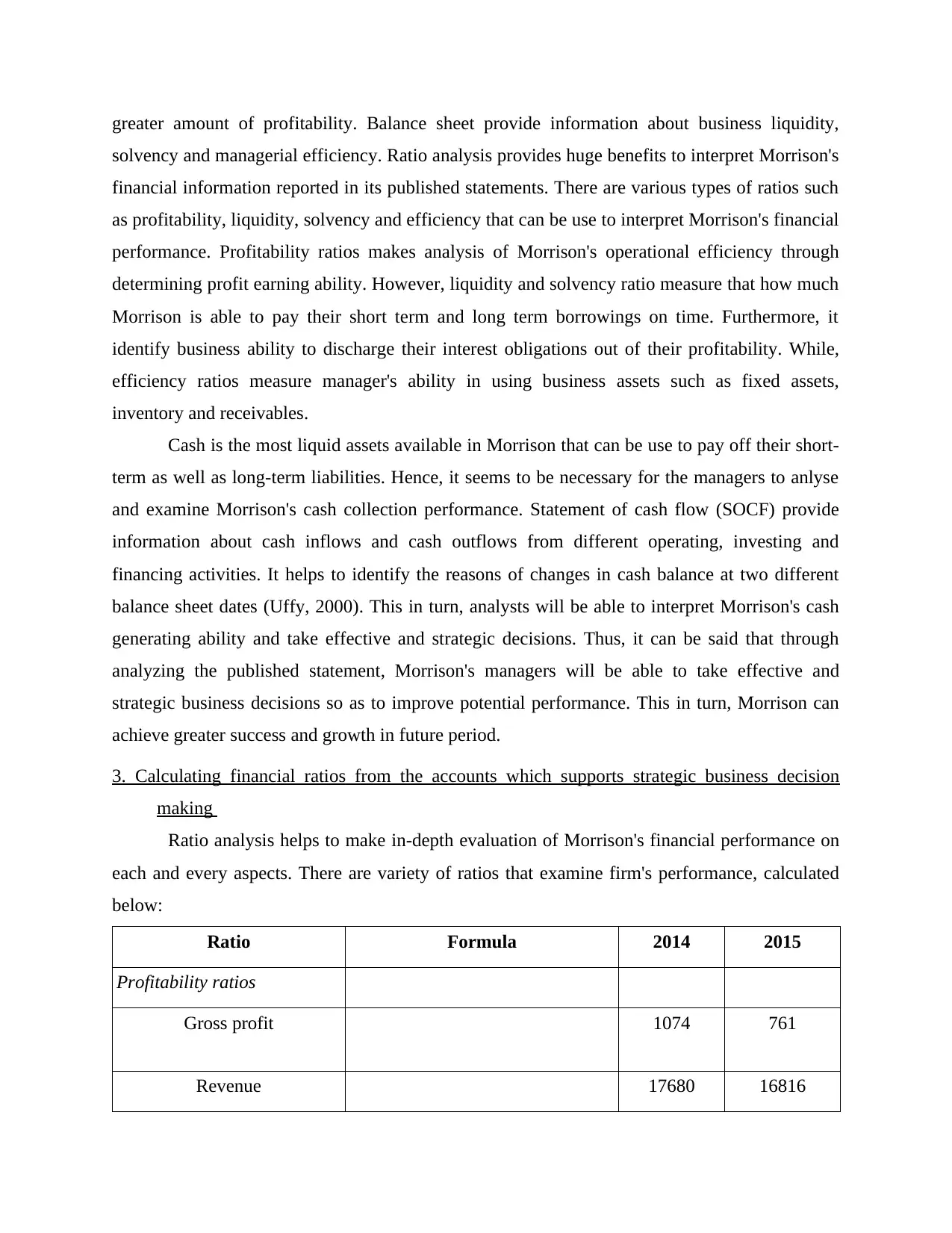
greater amount of profitability. Balance sheet provide information about business liquidity,
solvency and managerial efficiency. Ratio analysis provides huge benefits to interpret Morrison's
financial information reported in its published statements. There are various types of ratios such
as profitability, liquidity, solvency and efficiency that can be use to interpret Morrison's financial
performance. Profitability ratios makes analysis of Morrison's operational efficiency through
determining profit earning ability. However, liquidity and solvency ratio measure that how much
Morrison is able to pay their short term and long term borrowings on time. Furthermore, it
identify business ability to discharge their interest obligations out of their profitability. While,
efficiency ratios measure manager's ability in using business assets such as fixed assets,
inventory and receivables.
Cash is the most liquid assets available in Morrison that can be use to pay off their short-
term as well as long-term liabilities. Hence, it seems to be necessary for the managers to anlyse
and examine Morrison's cash collection performance. Statement of cash flow (SOCF) provide
information about cash inflows and cash outflows from different operating, investing and
financing activities. It helps to identify the reasons of changes in cash balance at two different
balance sheet dates (Uffy, 2000). This in turn, analysts will be able to interpret Morrison's cash
generating ability and take effective and strategic decisions. Thus, it can be said that through
analyzing the published statement, Morrison's managers will be able to take effective and
strategic business decisions so as to improve potential performance. This in turn, Morrison can
achieve greater success and growth in future period.
3. Calculating financial ratios from the accounts which supports strategic business decision
making
Ratio analysis helps to make in-depth evaluation of Morrison's financial performance on
each and every aspects. There are variety of ratios that examine firm's performance, calculated
below:
Ratio Formula 2014 2015
Profitability ratios
Gross profit 1074 761
Revenue 17680 16816
solvency and managerial efficiency. Ratio analysis provides huge benefits to interpret Morrison's
financial information reported in its published statements. There are various types of ratios such
as profitability, liquidity, solvency and efficiency that can be use to interpret Morrison's financial
performance. Profitability ratios makes analysis of Morrison's operational efficiency through
determining profit earning ability. However, liquidity and solvency ratio measure that how much
Morrison is able to pay their short term and long term borrowings on time. Furthermore, it
identify business ability to discharge their interest obligations out of their profitability. While,
efficiency ratios measure manager's ability in using business assets such as fixed assets,
inventory and receivables.
Cash is the most liquid assets available in Morrison that can be use to pay off their short-
term as well as long-term liabilities. Hence, it seems to be necessary for the managers to anlyse
and examine Morrison's cash collection performance. Statement of cash flow (SOCF) provide
information about cash inflows and cash outflows from different operating, investing and
financing activities. It helps to identify the reasons of changes in cash balance at two different
balance sheet dates (Uffy, 2000). This in turn, analysts will be able to interpret Morrison's cash
generating ability and take effective and strategic decisions. Thus, it can be said that through
analyzing the published statement, Morrison's managers will be able to take effective and
strategic business decisions so as to improve potential performance. This in turn, Morrison can
achieve greater success and growth in future period.
3. Calculating financial ratios from the accounts which supports strategic business decision
making
Ratio analysis helps to make in-depth evaluation of Morrison's financial performance on
each and every aspects. There are variety of ratios that examine firm's performance, calculated
below:
Ratio Formula 2014 2015
Profitability ratios
Gross profit 1074 761
Revenue 17680 16816
⊘ This is a preview!⊘
Do you want full access?
Subscribe today to unlock all pages.

Trusted by 1+ million students worldwide
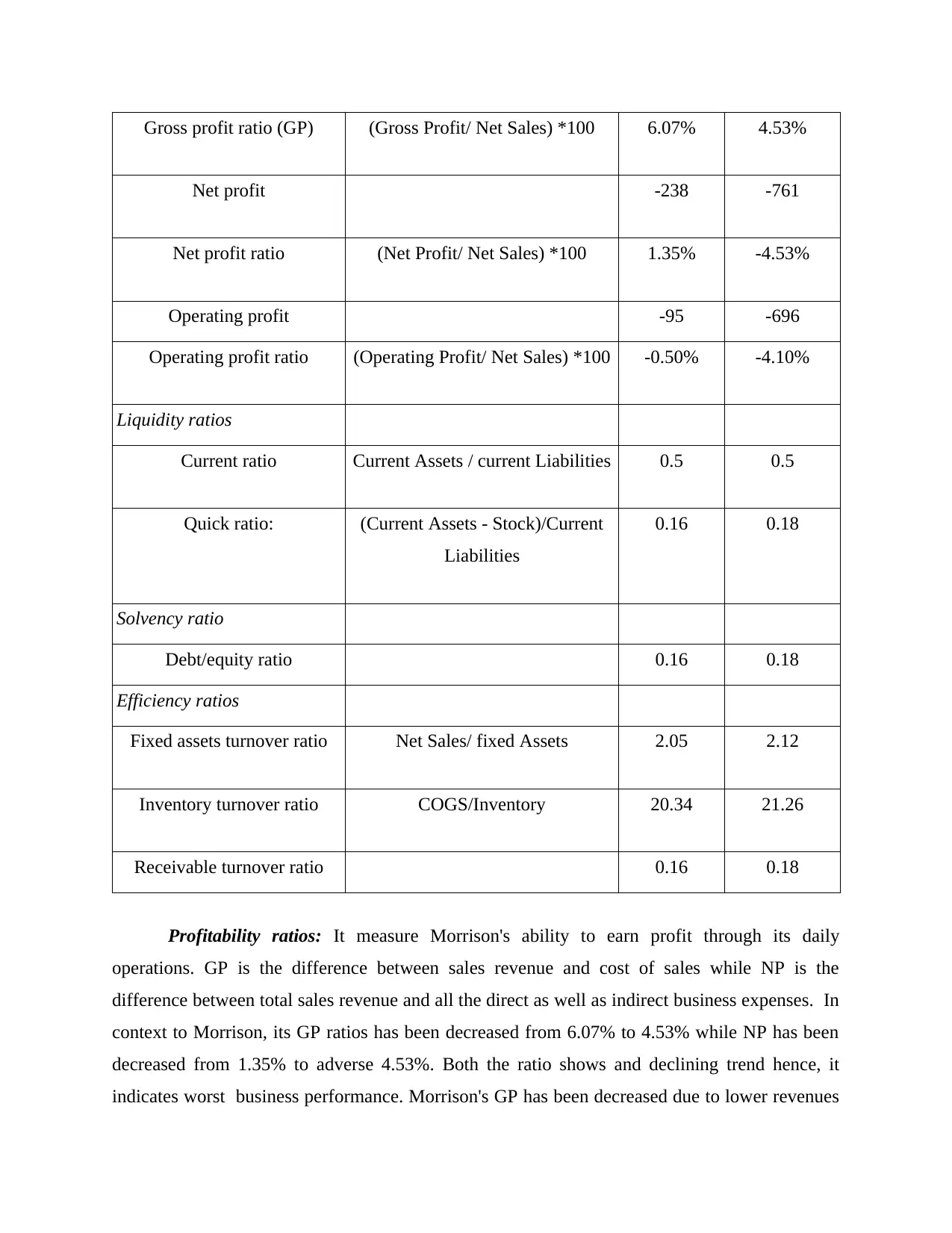
Gross profit ratio (GP) (Gross Profit/ Net Sales) *100 6.07% 4.53%
Net profit -238 -761
Net profit ratio (Net Profit/ Net Sales) *100 1.35% -4.53%
Operating profit -95 -696
Operating profit ratio (Operating Profit/ Net Sales) *100 -0.50% -4.10%
Liquidity ratios
Current ratio Current Assets / current Liabilities 0.5 0.5
Quick ratio: (Current Assets - Stock)/Current
Liabilities
0.16 0.18
Solvency ratio
Debt/equity ratio 0.16 0.18
Efficiency ratios
Fixed assets turnover ratio Net Sales/ fixed Assets 2.05 2.12
Inventory turnover ratio COGS/Inventory 20.34 21.26
Receivable turnover ratio 0.16 0.18
Profitability ratios: It measure Morrison's ability to earn profit through its daily
operations. GP is the difference between sales revenue and cost of sales while NP is the
difference between total sales revenue and all the direct as well as indirect business expenses. In
context to Morrison, its GP ratios has been decreased from 6.07% to 4.53% while NP has been
decreased from 1.35% to adverse 4.53%. Both the ratio shows and declining trend hence, it
indicates worst business performance. Morrison's GP has been decreased due to lower revenues
Net profit -238 -761
Net profit ratio (Net Profit/ Net Sales) *100 1.35% -4.53%
Operating profit -95 -696
Operating profit ratio (Operating Profit/ Net Sales) *100 -0.50% -4.10%
Liquidity ratios
Current ratio Current Assets / current Liabilities 0.5 0.5
Quick ratio: (Current Assets - Stock)/Current
Liabilities
0.16 0.18
Solvency ratio
Debt/equity ratio 0.16 0.18
Efficiency ratios
Fixed assets turnover ratio Net Sales/ fixed Assets 2.05 2.12
Inventory turnover ratio COGS/Inventory 20.34 21.26
Receivable turnover ratio 0.16 0.18
Profitability ratios: It measure Morrison's ability to earn profit through its daily
operations. GP is the difference between sales revenue and cost of sales while NP is the
difference between total sales revenue and all the direct as well as indirect business expenses. In
context to Morrison, its GP ratios has been decreased from 6.07% to 4.53% while NP has been
decreased from 1.35% to adverse 4.53%. Both the ratio shows and declining trend hence, it
indicates worst business performance. Morrison's GP has been decreased due to lower revenues
Paraphrase This Document
Need a fresh take? Get an instant paraphrase of this document with our AI Paraphraser
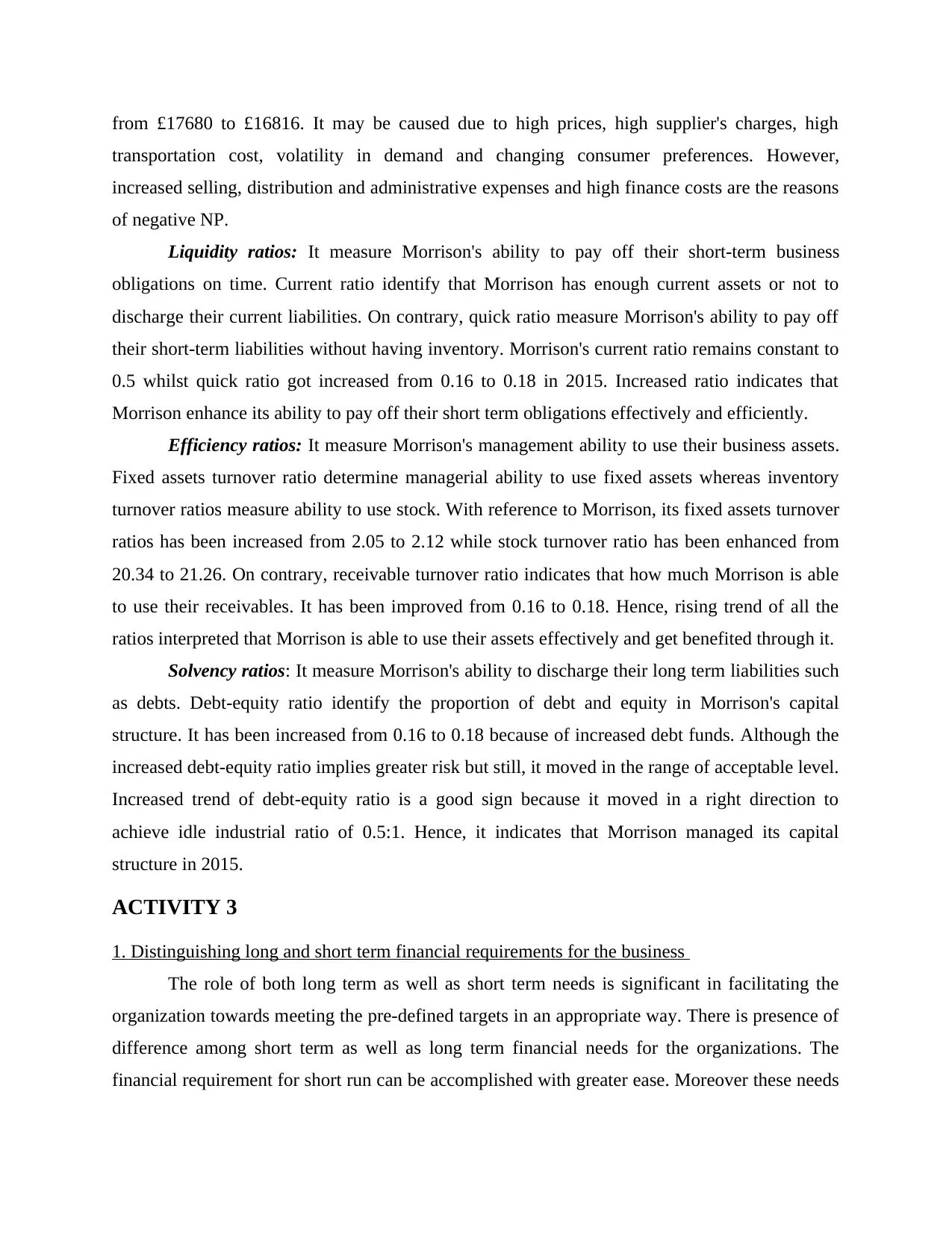
from £17680 to £16816. It may be caused due to high prices, high supplier's charges, high
transportation cost, volatility in demand and changing consumer preferences. However,
increased selling, distribution and administrative expenses and high finance costs are the reasons
of negative NP.
Liquidity ratios: It measure Morrison's ability to pay off their short-term business
obligations on time. Current ratio identify that Morrison has enough current assets or not to
discharge their current liabilities. On contrary, quick ratio measure Morrison's ability to pay off
their short-term liabilities without having inventory. Morrison's current ratio remains constant to
0.5 whilst quick ratio got increased from 0.16 to 0.18 in 2015. Increased ratio indicates that
Morrison enhance its ability to pay off their short term obligations effectively and efficiently.
Efficiency ratios: It measure Morrison's management ability to use their business assets.
Fixed assets turnover ratio determine managerial ability to use fixed assets whereas inventory
turnover ratios measure ability to use stock. With reference to Morrison, its fixed assets turnover
ratios has been increased from 2.05 to 2.12 while stock turnover ratio has been enhanced from
20.34 to 21.26. On contrary, receivable turnover ratio indicates that how much Morrison is able
to use their receivables. It has been improved from 0.16 to 0.18. Hence, rising trend of all the
ratios interpreted that Morrison is able to use their assets effectively and get benefited through it.
Solvency ratios: It measure Morrison's ability to discharge their long term liabilities such
as debts. Debt-equity ratio identify the proportion of debt and equity in Morrison's capital
structure. It has been increased from 0.16 to 0.18 because of increased debt funds. Although the
increased debt-equity ratio implies greater risk but still, it moved in the range of acceptable level.
Increased trend of debt-equity ratio is a good sign because it moved in a right direction to
achieve idle industrial ratio of 0.5:1. Hence, it indicates that Morrison managed its capital
structure in 2015.
ACTIVITY 3
1. Distinguishing long and short term financial requirements for the business
The role of both long term as well as short term needs is significant in facilitating the
organization towards meeting the pre-defined targets in an appropriate way. There is presence of
difference among short term as well as long term financial needs for the organizations. The
financial requirement for short run can be accomplished with greater ease. Moreover these needs
transportation cost, volatility in demand and changing consumer preferences. However,
increased selling, distribution and administrative expenses and high finance costs are the reasons
of negative NP.
Liquidity ratios: It measure Morrison's ability to pay off their short-term business
obligations on time. Current ratio identify that Morrison has enough current assets or not to
discharge their current liabilities. On contrary, quick ratio measure Morrison's ability to pay off
their short-term liabilities without having inventory. Morrison's current ratio remains constant to
0.5 whilst quick ratio got increased from 0.16 to 0.18 in 2015. Increased ratio indicates that
Morrison enhance its ability to pay off their short term obligations effectively and efficiently.
Efficiency ratios: It measure Morrison's management ability to use their business assets.
Fixed assets turnover ratio determine managerial ability to use fixed assets whereas inventory
turnover ratios measure ability to use stock. With reference to Morrison, its fixed assets turnover
ratios has been increased from 2.05 to 2.12 while stock turnover ratio has been enhanced from
20.34 to 21.26. On contrary, receivable turnover ratio indicates that how much Morrison is able
to use their receivables. It has been improved from 0.16 to 0.18. Hence, rising trend of all the
ratios interpreted that Morrison is able to use their assets effectively and get benefited through it.
Solvency ratios: It measure Morrison's ability to discharge their long term liabilities such
as debts. Debt-equity ratio identify the proportion of debt and equity in Morrison's capital
structure. It has been increased from 0.16 to 0.18 because of increased debt funds. Although the
increased debt-equity ratio implies greater risk but still, it moved in the range of acceptable level.
Increased trend of debt-equity ratio is a good sign because it moved in a right direction to
achieve idle industrial ratio of 0.5:1. Hence, it indicates that Morrison managed its capital
structure in 2015.
ACTIVITY 3
1. Distinguishing long and short term financial requirements for the business
The role of both long term as well as short term needs is significant in facilitating the
organization towards meeting the pre-defined targets in an appropriate way. There is presence of
difference among short term as well as long term financial needs for the organizations. The
financial requirement for short run can be accomplished with greater ease. Moreover these needs
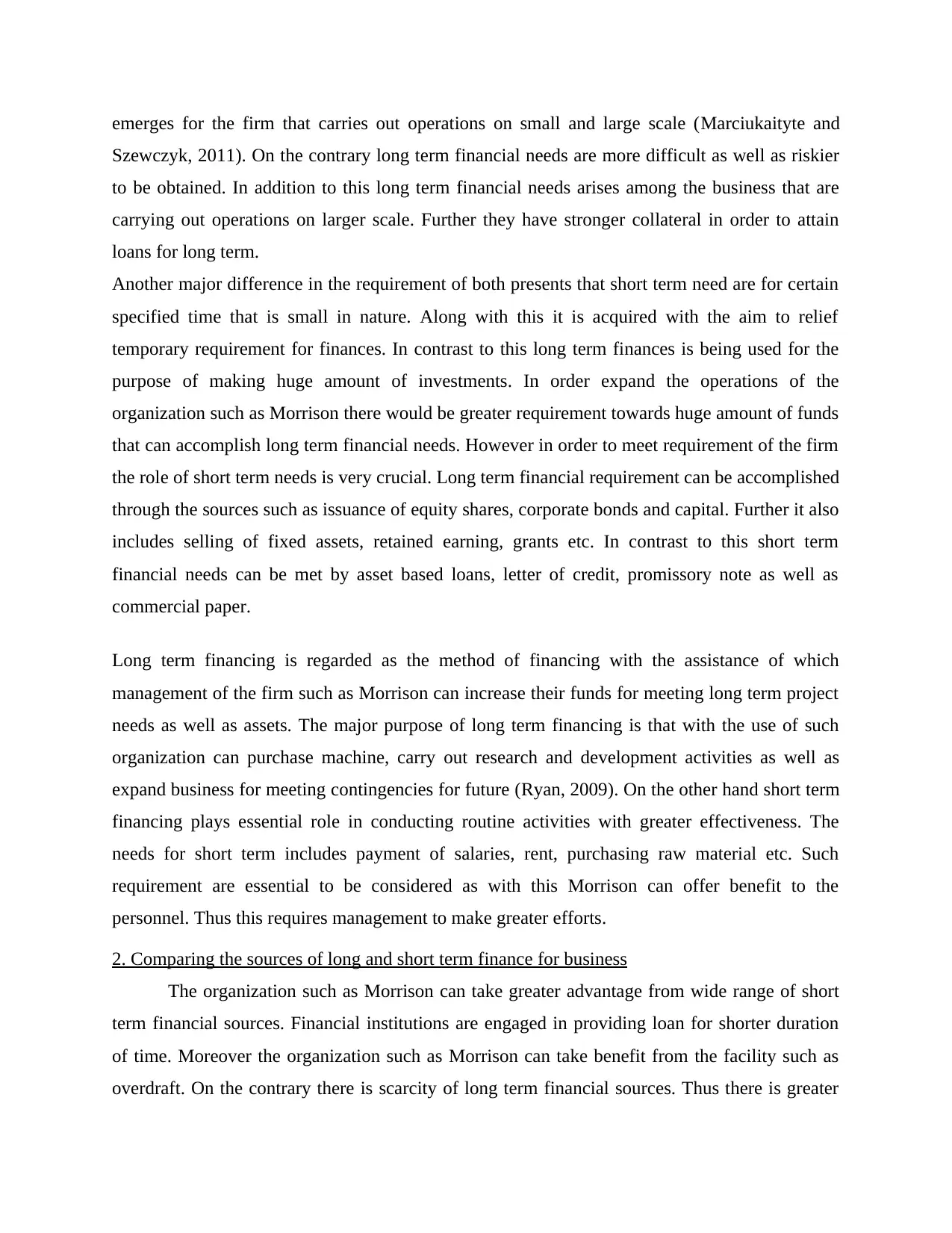
emerges for the firm that carries out operations on small and large scale (Marciukaityte and
Szewczyk, 2011). On the contrary long term financial needs are more difficult as well as riskier
to be obtained. In addition to this long term financial needs arises among the business that are
carrying out operations on larger scale. Further they have stronger collateral in order to attain
loans for long term.
Another major difference in the requirement of both presents that short term need are for certain
specified time that is small in nature. Along with this it is acquired with the aim to relief
temporary requirement for finances. In contrast to this long term finances is being used for the
purpose of making huge amount of investments. In order expand the operations of the
organization such as Morrison there would be greater requirement towards huge amount of funds
that can accomplish long term financial needs. However in order to meet requirement of the firm
the role of short term needs is very crucial. Long term financial requirement can be accomplished
through the sources such as issuance of equity shares, corporate bonds and capital. Further it also
includes selling of fixed assets, retained earning, grants etc. In contrast to this short term
financial needs can be met by asset based loans, letter of credit, promissory note as well as
commercial paper.
Long term financing is regarded as the method of financing with the assistance of which
management of the firm such as Morrison can increase their funds for meeting long term project
needs as well as assets. The major purpose of long term financing is that with the use of such
organization can purchase machine, carry out research and development activities as well as
expand business for meeting contingencies for future (Ryan, 2009). On the other hand short term
financing plays essential role in conducting routine activities with greater effectiveness. The
needs for short term includes payment of salaries, rent, purchasing raw material etc. Such
requirement are essential to be considered as with this Morrison can offer benefit to the
personnel. Thus this requires management to make greater efforts.
2. Comparing the sources of long and short term finance for business
The organization such as Morrison can take greater advantage from wide range of short
term financial sources. Financial institutions are engaged in providing loan for shorter duration
of time. Moreover the organization such as Morrison can take benefit from the facility such as
overdraft. On the contrary there is scarcity of long term financial sources. Thus there is greater
Szewczyk, 2011). On the contrary long term financial needs are more difficult as well as riskier
to be obtained. In addition to this long term financial needs arises among the business that are
carrying out operations on larger scale. Further they have stronger collateral in order to attain
loans for long term.
Another major difference in the requirement of both presents that short term need are for certain
specified time that is small in nature. Along with this it is acquired with the aim to relief
temporary requirement for finances. In contrast to this long term finances is being used for the
purpose of making huge amount of investments. In order expand the operations of the
organization such as Morrison there would be greater requirement towards huge amount of funds
that can accomplish long term financial needs. However in order to meet requirement of the firm
the role of short term needs is very crucial. Long term financial requirement can be accomplished
through the sources such as issuance of equity shares, corporate bonds and capital. Further it also
includes selling of fixed assets, retained earning, grants etc. In contrast to this short term
financial needs can be met by asset based loans, letter of credit, promissory note as well as
commercial paper.
Long term financing is regarded as the method of financing with the assistance of which
management of the firm such as Morrison can increase their funds for meeting long term project
needs as well as assets. The major purpose of long term financing is that with the use of such
organization can purchase machine, carry out research and development activities as well as
expand business for meeting contingencies for future (Ryan, 2009). On the other hand short term
financing plays essential role in conducting routine activities with greater effectiveness. The
needs for short term includes payment of salaries, rent, purchasing raw material etc. Such
requirement are essential to be considered as with this Morrison can offer benefit to the
personnel. Thus this requires management to make greater efforts.
2. Comparing the sources of long and short term finance for business
The organization such as Morrison can take greater advantage from wide range of short
term financial sources. Financial institutions are engaged in providing loan for shorter duration
of time. Moreover the organization such as Morrison can take benefit from the facility such as
overdraft. On the contrary there is scarcity of long term financial sources. Thus there is greater
⊘ This is a preview!⊘
Do you want full access?
Subscribe today to unlock all pages.

Trusted by 1+ million students worldwide
1 out of 20
Related Documents
Your All-in-One AI-Powered Toolkit for Academic Success.
+13062052269
info@desklib.com
Available 24*7 on WhatsApp / Email
![[object Object]](/_next/static/media/star-bottom.7253800d.svg)
Unlock your academic potential
Copyright © 2020–2025 A2Z Services. All Rights Reserved. Developed and managed by ZUCOL.





